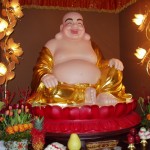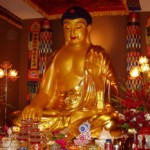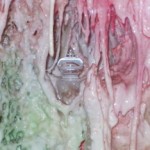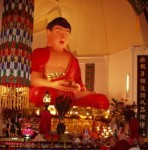
Zhaxi Zhuoma Rinpoche practicing the Green Tara Perfection Dharma as part of the opening ceremonies at Hua Zang Si.
Hua Zang Si, a Buddhist temple situated near the downtown of San Francisco (Mission District), specially selected December 26, 2004, the holy birthday of Amitabha Buddha, to perform a grand ceremony marking the opening of the temple. Since the temple furthers the great vows of the Buddhas, it received the empowerment of the Buddhas. Buddhists from countries all over the world rushed to San Francisco to participate in the large grand opening ceremony. That Dharma Assembly was solemn and wonderful.
A representative from World Buddhism Association, eminent Dharma Teacher Jue Hui, said in her speech that the opening of Hua Zang Si is good news for the western world. She said that the temple would increase good fortune and merit throughout the world. The famous Taersi in China, which is the temple of Master Tsongkhapa, the famous Tsurphu Monastery in China, which is the temple of the Karmapa Great Jewel Dharma Kings, the Tibetan Buddhism Association of America, and other Buddhist organizations around the world sent congratulatory messages to Hua Zang Si.
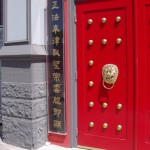
The meaning of the couplet at the side entrance to Hua Zang Si is that Buddhist disciples here follow the correct dharma of the Tripitaka (the sutras or discourses, the monastic discipline, and the commentaries or treatises) to cultivate themselves and quickly attain liberation from the cycle of reincarnation. The cornerstone bears the inscription in German of the Lutheran Church that once occupied Hua Zang Si.
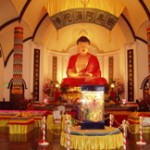
The “Yun Sculpture of Mt. Sumeru” by H.H. Master Wan Ko Yee is located in front of the twenty-one foot statue of Amitabha Buddha in Hua Zang Si. This Yun sculpture of Mt. Sumeru and the holy relics of the Buddha contained therein compose a unique treasure in this world.
Eminent Dharma Teacher Jue Hui said in her speech that Hua Zang Si is totally based upon the dharma taught by Shakyamuni Buddha. She said, “Hua Zang Si strictly abides by the Tripitaka and the esoteric scriptures in its practice and teaching of the Dharma. Hua Zang Si does not adopt the viewpoint of any particular sect to the exclusion of other sects and does not distinguish between the various schools.” She stated that the statue of Amitabha Buddha in Hua Zang Si is generally recognized as one of the most dignified-looking Buddhist statues in the world. She said that the three precious objects contained in Hua Zang Si are rare treasures in the world. “Thus,” she averred, “compared to other temples in the United States or the Western world, or compared to other temples in China or other Asian countries, Hua Zang Si is a very orthodox and authentic Buddhist temple. Hua Zang Si possesses the authentic, flawless, profound, and broad Buddha-dharma.”
Great Rinpoche Akou Lamo from Tibet, who is the Chief Rinpoche of Hua Zang Si, began the Dharma Assembly. Great Rinpoche Akou Lamo is one of the five great female rinpoches of Tibet. In accordance with Tibetan esoteric dharma and speaking the Tibetan language, she performed various rituals. Dachu Hengsheng Rinpoche, who is one of the great rinpoches of Tibetan esoteric Buddhism, practiced the Incense Dharma in Chinese. Zhaxi Zhuoma Rinpoche, practiced the Green Tara Perfection Dharma in English. The entire Dharma Assembly will last three months, since that is how long it will take to perform completely all of the rituals. Rinpoches and Dharma Teachers have been and will be using Chinese, Tibetan, and English to perform the Dharma rites and rituals.
Eminent monastics and laypersons of great virtue will teach dharma methods at Hua Zang Si based upon the individual’s particular innate capabilities. These dharma methods will not be restricted to any particular sect of Buddhism. Such teachings will lead people away from suffering and toward happiness. They may even result in the attainment of liberation from the cycle of reincarnation and completion of the path to becoming a buddha.

